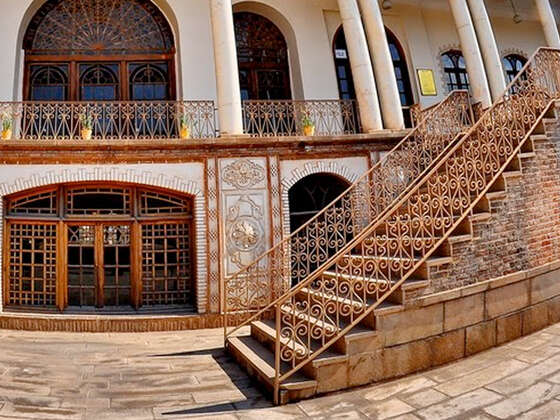Speak / Lesson 46
More About Pain and Illness
This week, we’re continuing with our kitchen Persian vocabulary, and learning practical conversations you would have in any household. In this lesson, we learn more vocabulary for how to talk about illnesses and pain. In addition, we learn words for more parts of the body.

Listen Now
Download lesson MP3GREETINGS:
hello
سَلام
how are you?
چِطوری؟
Note: In Persian, as in many other languages, there is a formal and an informal way of speaking. We will be covering this in more detail in later lessons. For now, however, chetor-ee is the informal way of asking someone how they are, so it should only be used with people that you are familiar with. hālé shomā chetor-é is the formal expression for ‘how are you.’
Spelling note: In written Persian, words are not capitalized. For this reason, we do not capitalize Persian words written in phonetic English in the guides.
ANSWERS:
I’m well
خوبَم
Pronunciation tip: kh is one of two unique sounds in the Persian language that is not used in the English language. It should be repeated daily until mastered, as it is essential to successfully speak Persian. Listen to the podcast for more information on how to make the sound.
| Persian | English |
|---|---|
| salām | hello |
| chetor-ee | how are you? |
| khoobam | I’m well |
| merci | thank you |
| khayli | very |
| khayli khoobam | I’m very well |
| khoob neestam | I’m not well |
| man | me/I |
| bad neestam | I’m not bad |
| ālee | great |
| chetor-een? | how are you? (formal) |
| hālé shomā chetor-é? | how are you? (formal) |
| hālet chetor-é? | how are you? (informal) |
| khoob-ee? | are you well? (informal) |
| mamnoonam | thank you |
| chetor peesh meeré? | how’s it going? |
| ché khabar? | what’s the news? (what’s up?) |
| testeeeee |
Leyla: Hello and welcome to Learn Persian with Chai and Conversation!
Matt: This week, we’re continuing with our kitchen Persian vocabulary, and learning practical conversations you would have in any household.
Leyla: We’re continuing this week with vocabulary that hopefully you wont’ have to use very often, and that is for when you are not feeling well.
Matt: As always, find previous lesson and bonus materials on our website at www.chaiandconversation.com, with chai spelled CHAI.
Leyla: But enough of that for now, Matt are you ready to begin the lesson/
Matt: Ready!
Leyla: Great, then let’s begin to learn Persian with Chai and Conversation
Leyla: First, let’s do a bit of a recap of the last lesson
So to say I’m not feeling well: halam khoob neest
I have pain: Dard daram
Leyla: We learned a way of saying exactly where you have pain, and that is by saying
saram dard meekoneh
Leyla: Using this structure, you can say many different things, like:
poshtam dard meekoneh
goosham dard meekoneh
Leyla: and so on. There’s another way of saying this. Let’s use the example of saram dard meekoneh. Instead you can say sardard daram. This is more akin to the structure used in English- I have a headache. Saram dard meekoneh is more like My head aches. I have a headache, sardard daram
you can also say
deldard daram
galoo dard daram
goosh dard daram
this is just a different way of saying it
let’s learn some other things that could be wrong:
sorfeh
we learned deldard daram, you could also say,
delam beham khordeh
bala ovordam
sookhtam
sargeejeh daram
feshar khoonam baalast
feshar khoonam payeeneh
Leyla: So if you are at home, and you want to see if there are any remedies for headaches, you can ask:
barayeh sardard cheezee dareem
let’s learn a few different remedies:
ghors
Leyla: so again the question: barayeh sardard cheezee dareem, and answer:
baleh, ghorseh sardard dareem.
kerem
shalgham
nabat
gherghereh namak
bokhoor
Leyla: To end the lesson, let’s try going over the different pains using vocabulary we learned last week, to make sure we retained the information. So again, we learned two different ways of talking about pain- for instance, with a headache you could either say ‘sar dard daram’ or ‘saram dard meekoneh’. So do you remember the word for shoulder Matt?
shooneh
Great, so what is I have shoulder pain using last week’s way of saying it’
shoonam dard meekoneh.
this week:
shooneh dard daram
Leyla: great. How about the same with if your arm hurts. Remember the word for arm and hand are the same.
Matt: dast
Leyla: So both ways of saying you have arm pain. Great. Let’s learn another area that a lot of people have pain in, and that is the knee- zanoo.
Matt: zanoo
So both ways of saying it.
Leyla: Great, and with that we end the lesson!
Matt: As always, thanks so much for joining us for this lesson of Learn Persain with Chai and Conversation.
Leyla: We want to remind you that we have a new website at www.chaiandconversation.com. If you haven’t had a chance to look at it already, please do so! We have a brand new design, and we’ve also been regularly adding blog posts to the website. It’s a great place to go for resources about the Perisan language.
Matt: In addition, we would love it if you could leave us an honest review of the podcast on iTunes- this is the best way for others to find out about the podcast, as well as to leave commentary about what you think about the podcast, including how we can improve.
We always welcome your suggestions. And until next time, khodahafez from ____
and beh omeedeh deedar from ____